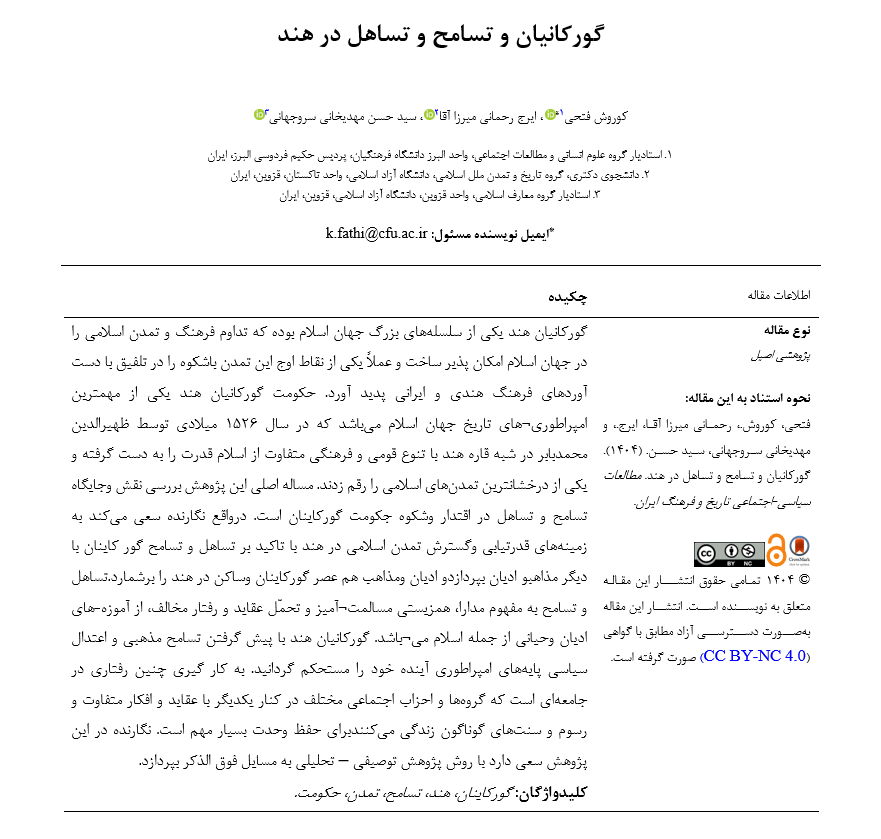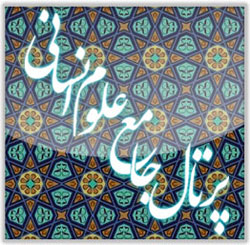The Mughals and the Policy of Tolerance in India
Keywords:
government, : Gorkainan, India, New Islamic Civilization, , toleranceAbstract
The Mughal dynasty of India was one of the major dynasties of the Islamic world, which enabled the continuation of Islamic culture and civilization and practically marked one of the peaks of this magnificent civilization through its synthesis with Indian and Persian cultural achievements. The Mughal Empire in India represents one of the most significant empires in Islamic history. It was established in 1526 CE by Zahir-ud-Din Muhammad Babur in the Indian subcontinent, a region characterized by diverse ethnicities and cultures, distinct from the Islamic world. The Mughals brought Islamic rule to this pluralistic region and established one of the most remarkable Islamic civilizations. The central issue of this study is to examine the role and significance of tolerance and forbearance in the power and glory of the Mughal government. In fact, the author seeks to explore the foundations of the rise and expansion of Islamic civilization in India, with an emphasis on the Mughals’ religious tolerance toward other religions and sects, while also identifying the contemporary faiths and religious communities residing in India during the Mughal period. Tolerance and forbearance, defined as leniency, peaceful coexistence, and the acceptance of differing beliefs and behaviors, are principles rooted in the divine religions, including Islam. By adopting religious tolerance and political moderation, the Mughal rulers solidified the foundations of their future empire. The implementation of such policies was crucial for maintaining unity in a society where various social groups and factions coexisted, each with distinct beliefs, customs, and traditions. In this study, the author employs a descriptive-analytical research method to address the aforementioned issues.
Downloads
References
Allami, A. (1893). Ain-i Akbari. Lucknow: [No publisher].
Badayuni, A., & Mowlavi Ahmad Ali Saheb, M. (2001). Selected histories (Vol. 2). Behran: Cultural Heritage and Treasures Association.
Dolafuz, T. F., & M. Taqi Fakhr Da'i Gilan, M. (1937). History of India. Tehran: Majlis Publishing.
Faiz Kashani, M. H. b. M. R., & Nasih, A. (1982). Kitab al-Ilm (The value of knowledge and scholars in Islam). [No publisher].
Farzand Vahi, J., & Ahmadi, F. (2020). Characteristics and features of Islamic civilization in verses and narrations. Journal of Science and Civilization in Islam(5), 98-113.
Fathali, M. (1999). New thoughts: Tolerance and ethical tolerance. Qom: Taha Cultural Institute.
Hikmat, A. A. (1958). The land of India. Tehran: University of Tehran.
Ibrahim Hassan, H., & Qasemi Payandeh, A. (2009). Political history of Islam. Tehran: Javidan Publishing.
Jahangir, N. M. (1980). Jahangirnama or Tuzuk-i Jahangiri. Tehran: Foundation of Iranian Culture.
Kardoush. (2005). Memories of India. Tehran: Ketabsara.
Lapidus, I. M. (2004). A history of Islamic societies from the beginning to the eighteenth century. Mashhad: Astan Quds Razavi.
Mousavi Bojnordi, S. M. (2005). The terminological definition of tolerance and ethical tolerance from the perspectives of Islam and the West. Tehran: Religious News.
Nehru, J. L., & Tafazoli, M. (1978). My life. Amir Kabir Publishing.
Nehru, J. L., & Tafazoli, M. (1987). Discovery of India (Vol. 1). Amir Kabir Publishing.
Saidi Roshan, M. B. (2014). Indicators of Islamic civilization based on the teachings of the Holy Quran. Mashhad: Quranic Teachings Publishing.
Spier, P. (2008). History of India (Vol. 2). Qom: Adyan Publishing.
Tabatabai, M. H. (1995). Al-Mizan fi Tafsir al-Quran (Vol. 3 & 14). Qom: Islamic Publications Office of the Society of Teachers of Qom Seminary.








